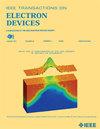Energy-Efficient CNN Accelerator Using Voltage-Gated DSHE-MRAM
IF 2.9
2区 工程技术
Q2 ENGINEERING, ELECTRICAL & ELECTRONIC
引用次数: 0
Abstract
Modern convolutional neural networks (CNNs) architectures need millions of parameters to be stored and computed in hardware for image classification. This needs a huge amount of memory and power in conventional hardware accelerator architectures. The concept of neuromorphic and in-memory computing (IMC) using emerging memory technologies has led to energy-efficient computations for hardware accelerators. This work presents a voltage-gated dual-bit spin Hall effect (VG-DSHE) magnetic random access memory (MRAM) device-based accelerator. The VG-DSHE-MRAM provides efficiency in terms of power and speed as compared to other MRAM devices. A crossbar array is implemented using VG-DSHE devices to exploit high-density storage, energy-efficiency, and fast multiply and accumulate (MAC) computation. Finally, a complete hardware implementation of CNN architecture is presented for image classification using the CIFAR-10 dataset without any significant accuracy degradation. The proposed VG-DSHE-based CNN accelerator is使用电压门控DSHE-MRAM的节能CNN加速器
现代卷积神经网络(cnn)架构需要在硬件中存储和计算数百万个参数来进行图像分类。在传统的硬件加速器架构中,这需要大量的内存和功率。神经形态和内存计算(IMC)的概念使用新兴的内存技术导致硬件加速器的节能计算。本文提出了一种基于电压门控双比特自旋霍尔效应(VG-DSHE)磁随机存取存储器(MRAM)器件的加速器。与其他MRAM设备相比,VG-DSHE-MRAM在功率和速度方面提供了效率。利用VG-DSHE器件实现了一种具有高密度存储、高能效和快速乘法累加(MAC)计算能力的交叉棒阵列。最后,提出了一个完整的CNN架构的硬件实现,用于使用CIFAR-10数据集进行图像分类,而不会显著降低准确率。与基于差分自旋霍尔效应(DSHE)的传统设计相比,本文提出的基于VGG8、VGG16、AlexNet和ResNet18架构的CNN加速器节能2.1倍,吞吐量效率分别为1.57、0.49、0.035和0.018 tsps /W。此外,将所提出的加速器与AlexNet架构的其他新兴存储器进行了比较,结果显示,与相变存储器(PCM)、电阻式随机存取存储器(RRAM)、自旋传递扭矩(STT)、自旋轨道扭矩(SOT)和DSHE相比,交叉条功耗分别提高了181倍、14.76倍、2.4倍、2.25倍和2.1倍。
本文章由计算机程序翻译,如有差异,请以英文原文为准。
求助全文
约1分钟内获得全文
求助全文
来源期刊

IEEE Transactions on Electron Devices
工程技术-工程:电子与电气
CiteScore
5.80
自引率
16.10%
发文量
937
审稿时长
3.8 months
期刊介绍:
IEEE Transactions on Electron Devices publishes original and significant contributions relating to the theory, modeling, design, performance and reliability of electron and ion integrated circuit devices and interconnects, involving insulators, metals, organic materials, micro-plasmas, semiconductors, quantum-effect structures, vacuum devices, and emerging materials with applications in bioelectronics, biomedical electronics, computation, communications, displays, microelectromechanics, imaging, micro-actuators, nanoelectronics, optoelectronics, photovoltaics, power ICs and micro-sensors. Tutorial and review papers on these subjects are also published and occasional special issues appear to present a collection of papers which treat particular areas in more depth and breadth.
 求助内容:
求助内容: 应助结果提醒方式:
应助结果提醒方式:


